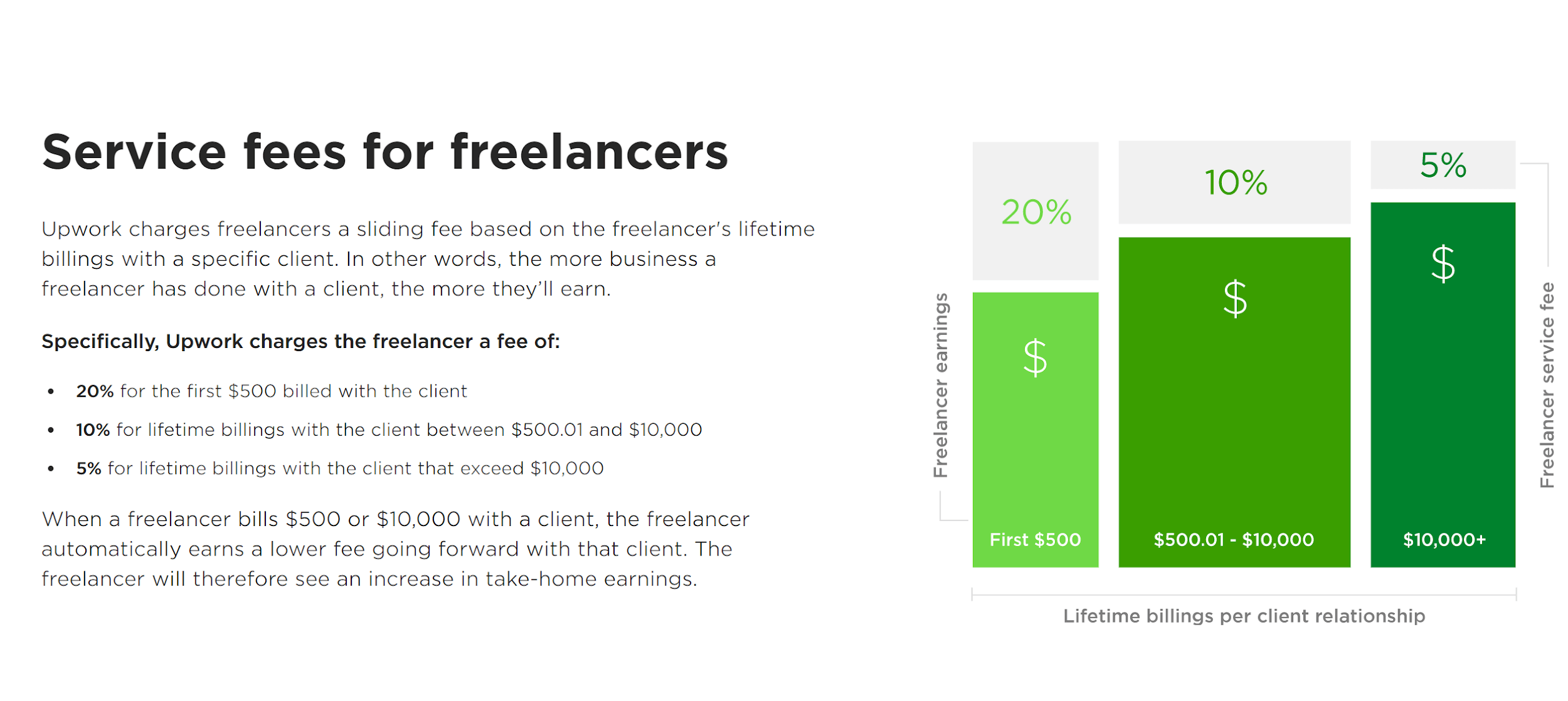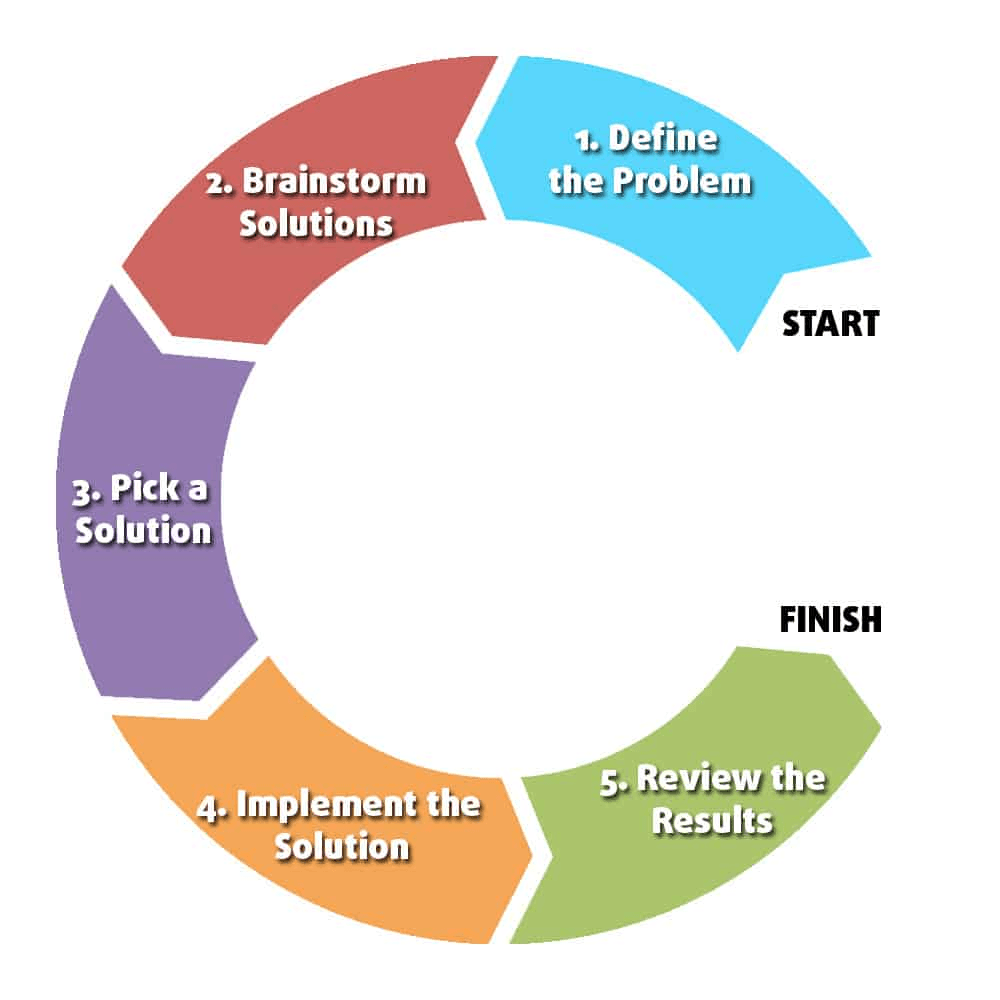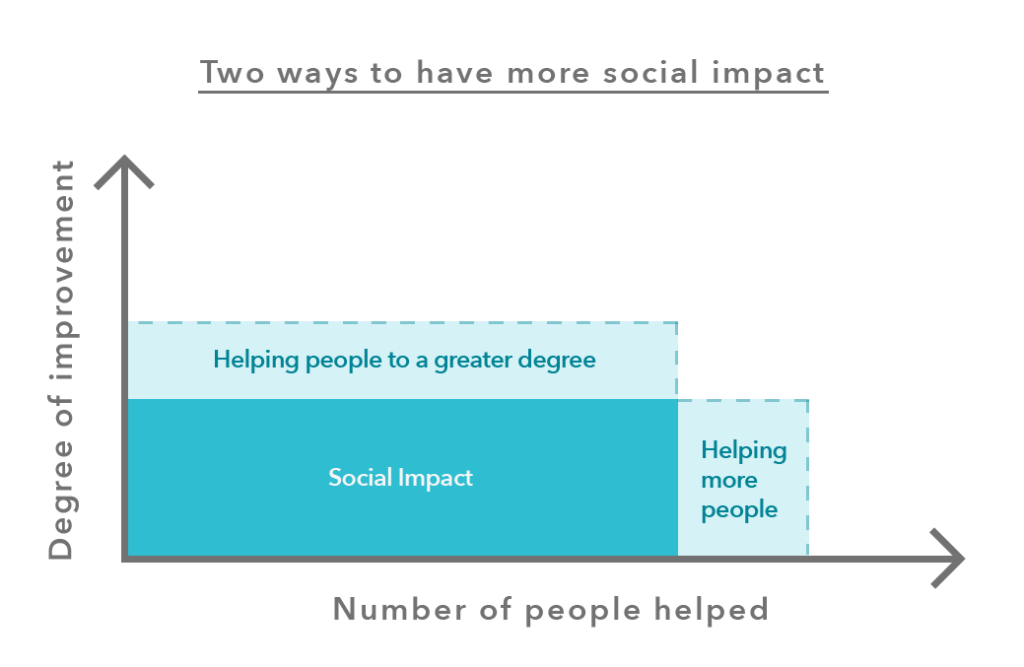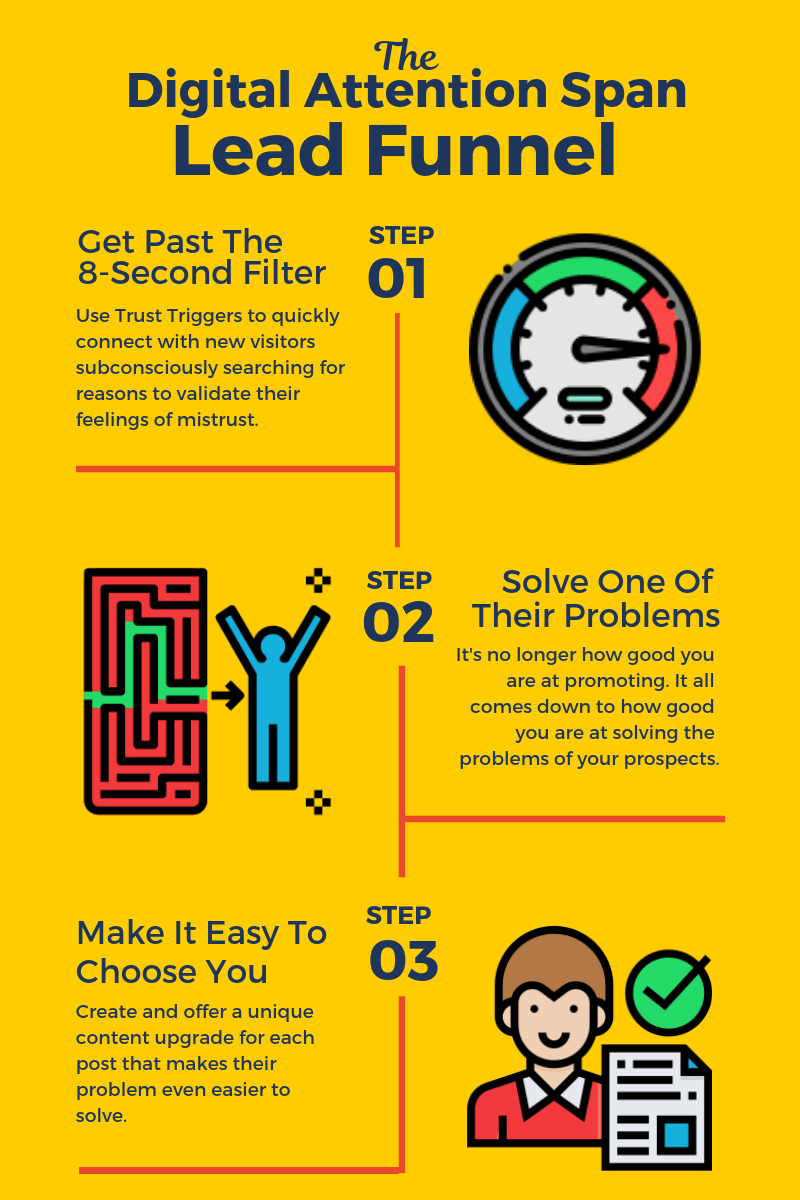Are you a freelancer escaping Upwork?
I’ve said it before, and I’ll say it again:
If you’re freelancing on Upwork, then you’re not really freelancing – you’re racing to the bottom of the commodity marketplace and straight toward burnout.
And now that Upwork charges you simply to bid on jobs (with new freelancers needing to submit tens if not hundreds of bids before they can land a gig), this is only going to get worse:
“To bid on projects on the platform, freelancers must use what are called ‘Connects.’ Starting in May [2019], freelancers will need to use one to six Connects, priced at 15 cents a connect, to submit a proposal for a job they are interested in. The number of Connects will be calculated on the project’s value. No Connects will be free. Freelancers will have to buy them in bundles of 10 or more.” – Forbes
Add this to the fact that Upwork already takes a cut of your profits (up to 20%!), and the ‘freelancing squeeze’ is starting to look a lot more like a straight up stranglehold.

For the freelancers who believe there is no where else to go to find work, this new change could spell the end of many freelancing careers, and some serious overwork and penny-pinching for many more.
Which is exactly why we’re taking a moment to hit the brakes and dispel that myth.
“The truth is, marketplaces are not designed for you to succeed. At least, not if you want to run a business where you can charge what you’re worth.” – James Johnson
And yet the number of freelancers breaking six figures per year is growing by an average of 10% each year, which means there’s a better, and more lucrative way, to run and grow your freelance business than relying on sites like Upwork.
In this post, we’re going to share a simple framework for client-getting you can use when you need new clients fast, to help you permanently escape Upwork and other marketplace sites like it.
As Mike Shreeve, founder of The No Pants Project, shares in the podcast episode, ‘How to Get Clients Fast’:
“The purpose of this is to help you uncomplicate whatever situation you’re in, even if you aren’t in dire circumstances.
“There’s a lot of different ways to get clients. Most of them work – that’s the problem.
“The problem with creating a freelance business in 2019 is that nearly everything works – if you work it. So that means everything has pros and cons, and if you’re trying to figure it out, it’s very, very confusing.
“To get where you want to go, you only need three things though.”
The first of which is…
Step 1: Nail Down Your Offer
Probably the biggest contributing factor to Upwork’s “race-to-the-bottom” culture is the fact that it is designed to commoditize the freelancers it connects clients with by asking them to describe themselves only in terms of the skills they are offering.
The problem with offering a skill is that it requires potential clients to be aware of the value of the skill and exactly how to use it in their business, and it encourages commoditization because a skill is something anyone can learn and claim.
Which is why most clients on Upwork are simply looking for the cheapest provider with the skills they’re looking for.
In order to freelance successfully, and outside of marketplaces, you need to understand that a skill is not an offer.
“Here’s what I mean. Most freelancers don’t offer anything. They just tell people what their skills are. That isn’t an offer. If I come up to you on the street and say, ‘I can juggle,’ did I offer you anything?
“No, I just told you I can juggle.
“A lot of people when they’re pitching clients say: I can write words, I can design logos, I can program stuff. Okay, well thank you very much for telling me and that’s wonderful, but I have a long list of people who are saying something similar and I’m just trying to have my problem solved.
“An offer is that plus something else. I write words and I’d like to offer that skill to you in order to help you make more sales. I am very good at garden design and I’d like to design for you the perfect garden so that you can enjoy it with your family.” – Mike Shreeve
To get clients outside of a marketplace, good clients, you need to offer solutions.

Depending on your skills and the niche your working with, a solution could be a result your prospects are looking for such as more sales, or a specific outcome like losing 20 pounds.
The point is that when you’re talking to people you’d like to work with, you aren’t just telling them what skills you have, but rather what you are able to do and create with those skills in order to solve their problems.
In fact, the time you spend talking about your own skills should be minimal, replaced by explanations about the exact ways you can make your clients’ lives easier, and less stressful.
Because every time a client comes out looking and hiring for a skill set, they are actually adding even more to their own plates – they now have to fit you in with their team and manage you, keep an eye on things and figure out if what you’re doing is creating value.
When you offer a result, you’re telling potential clients that they don’t need to manage you – you will come in and create the result, and the client will know you’ve done your job because they will either have or not have the outcome they wanted.
This also ensures that potential clients understand the true value of what you bring to the table, which allows you to charge more and work with better clients who respect you and your time.
Creating an offer, rather than offering a skill, is probably the biggest change you’ll need to make coming from an Upwork, marketplace mentality.
But getting this nailed down will literally transform your freelancing business in all the right ways.
As Benek Lisefski, freelance Art Director and UX/UI Designer, writes:
“Ignore the dangerous advice that you can hit it rich on cheap marketplaces. Your ideal clients don’t live there. You might land that big job, but even the biggest and best of Upwork are small fish in the sea of freelancing. Jump out of your little pond and join the big fish, little Nemo.”
Step 2: Find Someone To Make Your Offer To
This comes down to understanding who both values the result you’re offering and has a salient need for it right now.
There are a couple ways to approach this, depending on how experienced you are and how long you’ve been freelancing.
If you’re fairly new as a freelancer and more open to learning and developing yourself, you can make this whole process easier by starting with finding a niche that has a specific problem you can empathize with, and then developing your offer and skills to solve their problem.
You could do this by joining entrepreneurial groups on Facebook and LinkedIn, and then keeping an eye on the kinds of questions members are asking and help they are asking for.
If you start to notice a trend, then you’ve found a salient problem that you could develop and offer a solution to.
On the other hand, if you have a specialized skill set you’ve already spent years developing or know is your “zone of genius,” your best bet is to go out and do some listening in groups that you already know can and should be using your skills to create results.
Then you can start to absorb the way these people talk about their problems and the results they really want when they start looking for people with your skill set, and can leap above the competition into a market of one by offering the result rather than the skill.
The major takeaway here is to find the people who are looking for help or at least aware of the problem you solve, and hang out where they do. Use those spaces as places to find people, develop relationships with them, and make your offer.
Great spaces you can usually find groups like this to listen in on are Facebook and LinkedIn.
And for those of you who have been in the freelancing game for a while now, with a good string of previous clients under your belt, you can use that to help you decide on your “ideal client.”
Think of your best clients from Upwork.
Who were the ones that were happiest to have worked with you or kept coming back, as well as the ones you enjoyed working with most?
What did you do to help them and what did they appreciate so much?
What results did you create together?
Use the answers to these questions to determine who your ideal client is (as well as the results they value the most) and where you can start looking for more of them – similar types of people usually run in the same circles.
You can also reach out to previous clients that were ideal, or close to it, from Upwork and ask for referrals, and use your Upwork testimonials on your own site to promote yourself as well as build case studies from the results you’ve achieved.
After that, jump in some groups and online spaces you know your ideal clients frequent, and start interacting to find more potential ideal clients.
Mike says:
“What you need to do is take the offer that you have and find people who stand to gain the most from it.
If you want to make this easy on yourself, look for the pain that people have – it doesn’t have to just be emotional pain or physical pain.
What does a business owner feel frustrated about? What are your friends frustrated about? What is a problem someone has that you think you could solve? Maybe not with just your technical skills, but with a combination of other skills.
There’s your offer.”
And remember – an offer is a result or outcome you deliver, not a skill, and niching down and getting very specific about who you serve is the best way to guarantee success for yourself and your clients.
Very likely, you’ll need to use a bunch of different skills, both technical and soft, in order to make good on your offer, but that’s exactly what sets you apart and makes you unique – and therefore premium – to your ideal clients.

Step 3: Decide On A Method For Getting The Attention Of Your Prospects So You Can Make Your Offer.
Now that you’ve decided on your offer and have someone to offer it to, you need to decide on a method you can use consistently and frequently to capture their attention.
Here’s an important formula to remember:
AIDA – Attention, Interest, Desire, Action
Before you can create Interest, Desire, or Action, you need to get a person’s Attention.
You can do this by going to the spaces online where your ideal clients hang out and dropping value bombs, answering questions, writing articles and just generally interacting with prospects before you offer your services.
You can do this with cold outreach via email or LinkedIn, where you capture attention by creating a personal connection, or demonstrating empathy to their specific pain, before you make any offers.
(I recommend cold outreach for the fastest results, and we have a guide to help you send successful cold outreach here.)
You can even build an email list using an ad funnel, if you have the funds on hand, and send daily emails out to get your list familiar and comfortable with you, as well as how you can help them.
The important part is to choose a method that you can commit to following through on daily. Frequency is the key to acquiring new clients fast, because it builds up relationships with potential clients and therefore builds trust.
“See, the problem with most people is they just make their offer. They forget the step of getting their attention first. Human beings are attention driven creatures, meaning it’s easy to get distracted because we are driven by things that draw our attention.
“That’s why headlines are so critical in blog post writing or creating posts. It’s why less talented people have more success in many of the creative fields.
“It’s because they may not be technically better than you, but they are better at getting attention, because they understand human beings are driven by attention. And when you have someone’s attention, then you can make your offer to them.” – Mike Shreeve
Remember: when you’re interacting with potential clients in these spaces or reaching out to them cold, focus on adding value first.
Take the time to research and understand their particular problems and then offer your insights on how they might be able to solve them, with or without you, before offering to deliver the results yourself.
This works well because people are ultimately interested in one thing above all others – themselves.
Which means that when you make your outreach all about them, their goals and their pains, you’ll naturally catch and hold their attention.
Then, you have an opportunity to make them an offer that will be better received because you’ve demonstrated that you understand them and what they need.
Upwork was all about bidding and hoping to be found or noticed – making you mostly passive in your own business growth.
To build a true freelancing business, you’re going to take a more proactive approach by hand-picking your prospects and shifting the conversation from skills and experience to results you already know they are looking for.
“Go hunt down your ideal job. Be proactive — cold-email if you have to! Pitch a well researched, confident idea to one dream client and see how they react. Land one of those, and you’ve done more towards building your successful freelance career than you would have done from years of Upworking.” – Benek Lisefski
For more options and help with cold outreach and client getting strategies, check out these in-depth guides to narrow down which is right for you.

The Battle Plan For Escaping Upwork – Permanently:
There are so many methods for getting new clients that work, but because of that it’s easy to get overwhelmed.
Here’s what veteran freelancer and Head Troublemaker of The No Pants Project Mike Shreeve says you really need to do in order to get clients fast:
“If what you’re currently doing is not helping you to make something to offer, identify someone to offer it to who can benefit in a big way, or get those specific people’s attention so you can offer it to them, then very likely whatever it is you’re doing is not only not contributing to getting clients, it’s probably ruining your chances.
“So my recommendation to you, my friend, is to just use these three very simple checklist items:
- Something to offer
- Someone to offer to who could benefit from it, and
- A way to get their attention so you can offer it to them
“Use these checklist items as a way to be sure that whatever you’re doing helps you sustain the focus and the ability to put in the work that is required to get the results that you’re looking for.”
To get more details about this foundational approach to fast client getting, check out Mike’s podcast episode, “How To Get Clients Fast”.
And for direct help, guidance, and coaching when it comes to deciding on your offer, your ideal client, and your attention-getting, offer-making method, join us in The No Pants Project.
Inside, you’ll find everything you need to Build A $26,500 Per Month Freelance Business From Scratch.





